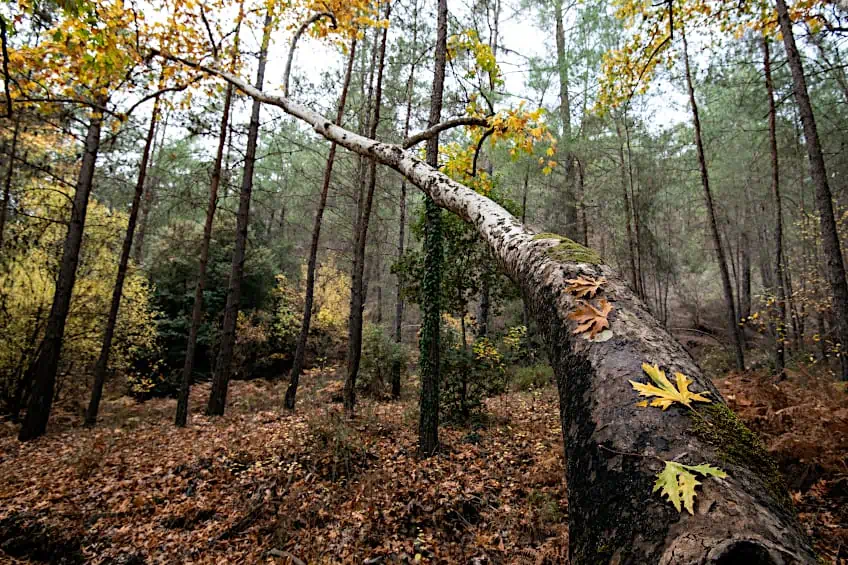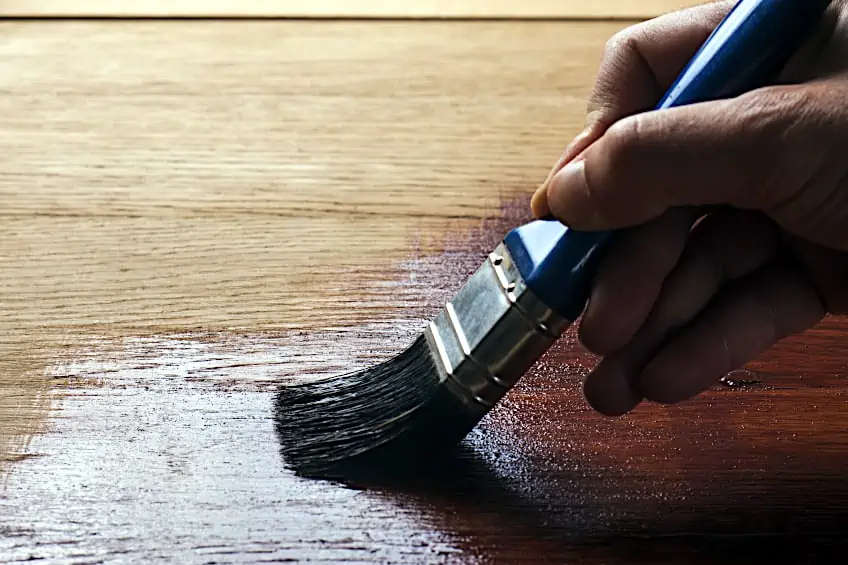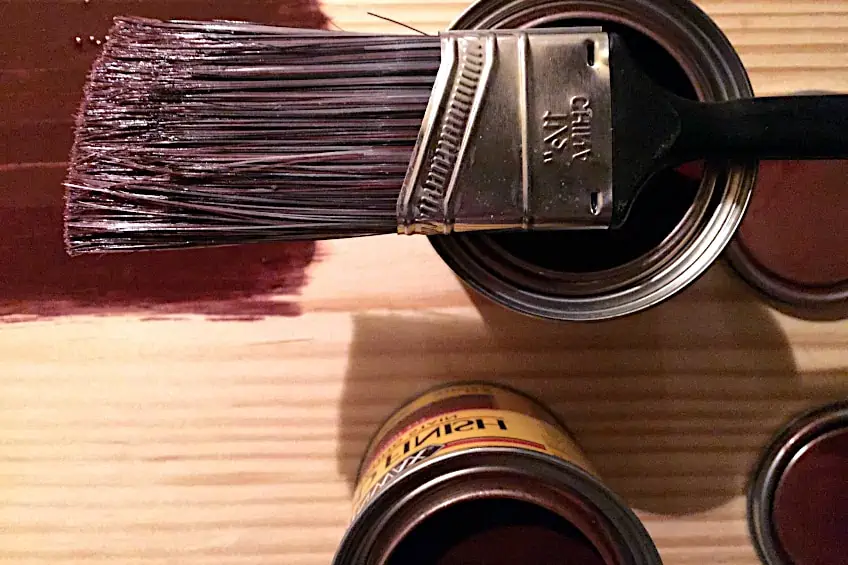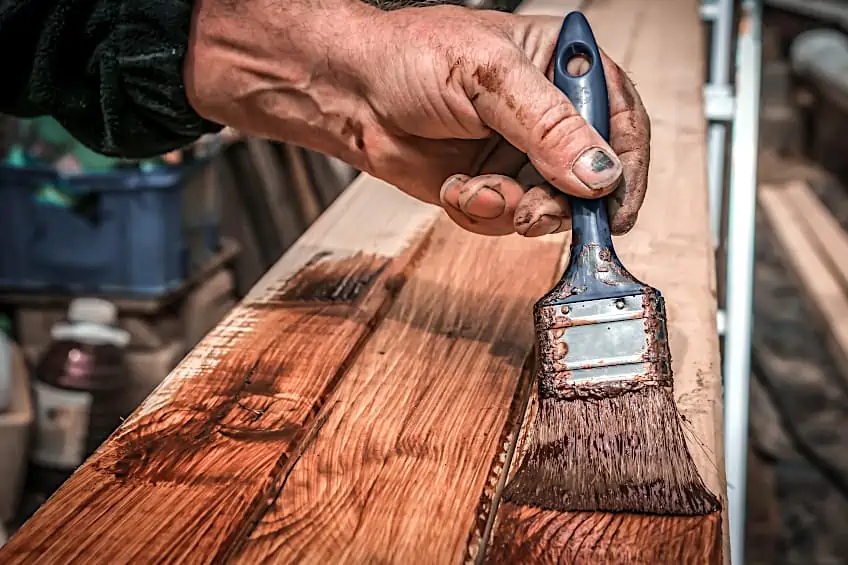Best Stain for Maple – Stains that Work on Maple Wood
This post may contain affiliate links. We may earn a small commission from purchases made through them, at no additional cost to you.
Wood has always been a huge part of our lives as a species. From constructing our homes to fashioning our tools and weapons, wood has changed and continues to change the way we live our lives. These days wood has taken on more of a decorative role, from being used in our living rooms as furniture to being used to fashion our kitchen countertops and tables, wood makes a great finish and ensures that our homes always have a warm cozy feel. One of the most common types of wood used to furnish our homes is maple wood, but this can be a challenging wood to customize. This being said, let’s have a look at what maple wood is and what makes it one of the most challenging wood boards to stain and treat, as well as the best way for you to go about treating it in the future.
Table of Contents
What Is Maple Wood and Why Is It Difficult to Stain?
Before we get into how you should go about staining maple wood it’s probably a good idea to fill you in on what exactly maple wood is, where it is found, some of its key characteristics, and what makes it so challenging to stain compared to other woods.

What Is Maple Wood?
Maple wood belongs to a family of trees called Aceraceae which consists of around ten species, of these ten types of trees about five of them are used for conventional applications of lumber like furnishings and construction. Maple trees are found in both the US and Canada and have been pretty well managed, so they don’t pop up on any endangered species list, which is good for you considering that you’re looking to stain some maple wood.

We’re able to get lots of great quality wood out of maple trees as they grow up to 88 feet on average, which makes it one of the popular wood types all over the country. It’s not just the look and feel of maple wood that makes it great, it’s also one of the strongest, heaviest, and tightly grained woods out there with a really fine grain texture.
The heartwood and sapwood of maple trees are also quite unique compared to other trees in its class. Heartwood refers to wood deep inside the tree’s core which tends to be a reddish-brown in appearance, whereas sapwood refers to the wood closer to the bark of the tree which tends to be an off-white color in most cases. Strangely, the sapwood of maple trees can fetch a lot more money in certain markets compared to its heartwood due to its unique color, strength, and malleability.

Although there are crafters and professional woodworkers that swear by using this wood type it can be a bit of a challenge to work with compared to softer woods, the trade-off is that workpieces created with this type of wood are beautiful, robust, and if treated correctly can last for a lifetime. Taking all of this into account, it comes as no surprise that many people prefer putting in the extra effort of staining maple instead of opting for a more cooperative wood or composite material.

What Makes Maple Wood So Difficult to Stain?
There’s nothing quite like a good wood stain finish off a beautifully crafted workpiece, especially one made of maple. If you have ever tried to stain maple you might have noticed that it isn’t particularly cooperative in this aspect. Why is maple this difficult to stain though? Well, it’s not exactly a revelation, in fact, most hardwoods are difficult to stain, and this has a lot to do with the grain of these woods.

Maple is what’s known as a medium hardwood, and what makes hardwood, well, hard, is the fact that their grains are tightly packed together. This is what gives maple the beautiful thin lines that allow the eye to follow the form of workpieces crafted by it. Now, this might be stunning to behold, but it also makes the wood less receptive to coatings and wood treatments than softer woods.

If you’re wondering why this is, it’s because a tighter wood grain means that the actual wood fibers are so tightly pressed together that coatings and treatments have a hard time seeping in and absorbing into the fibers of the wood. In the wild, this allows trees to be less vulnerable to things like mold, insect infestation, and even harmful chemicals that would otherwise damage their roots and heartwood.

Ultimately, the same thing that makes this wood something special to work with and allows us to craft beautiful furnishings from it is the one that makes it rather challenging to stain. Staining maple isn’t impossible though, and with some effort, patience, and termination, there are ways around these woods’ natural defenses that will allow you to achieve a darker aesthetic.
If you think that you can brute force your way through, the results might be less than satisfactory, especially if you’re using a pigment stain. Using this type of stain typically results in a really blotchy look, with some spots barely receiving any stain and others being so saturated with stain that they appear black even when observed up close.

What Types of Stain Work on Maple Wood?
We mentioned previously that there are types of wood stain that simply won’t work on maple wood, but there are a few types of wood treatments that will allow you to achieve a darker tone with far less effort. Therefore, we have taken it upon ourselves to provide you with a shortlist of wood treatments that you can use to treat your maple wood workpiece and some that you can’t.
| Type Of Wood Stain | Does It Work on Maple? |
| Oil-based wood stain | ✔ |
| Gel-Based wood stain | ✔ |
| Varnish wood stain | ✘ |
| Water-based wood stain | ✔ |
| Lacquer-based wood stain | ✘ |
| Metalized dye stain | ✘ |
| Water-soluble wood stain | ✔ |
| Tung oil | ✔ |
| Linseed oil | ✔ |
What Is the Best Stain for Maple Wood?
There are hundreds, if not thousands, of stains for maple wood on the market today. Although, much like everything else these days you definitely get what you pay for, and going for the cheaper option might end up in you regretting saving those few dollars. There are exceptions to the rule though, so let’s have a look at some of what we consider to be the best stain for maple out there.

Best Oil Stain for Maple: GENERAL FINISHES Oil Based Penetrating Wood Stain
If you’re looking for the best stain for maple, one of the go-to choices would be an oil-based wood stain. Oil-based stains have been around for a long time and are really effective because of their ability to penetrate deep beneath the surface of the wood and bond with the wood fibers. Not all oil stains are equal though, and when working with maple you’re going to want to go with the best quality stain you can find to ensure that it penetrates the tightly woven grain.
One of the best oil-based stains for maple wood is made from the General Finishes, which comes as no surprise considering they’ve been around since 1928. This team has pretty much written the book on wood stain, and nowhere is this better illustrated than in their oil-based penetrating wood stain for maple wood. What makes this wood stain so special though?
Well, if you’re working with maple wood, you’re going to want a wood stain formula capable of deep penetration without losing the potency of its effects. General finishes formula does just this and ensures uniform color across the surface of your board. It even prevents streaking and blotching by implementing dye instead of pigment to achieve the color of the stain.
If you’re having trouble matching or deciding on the stain color you’d like to apply, the General Finishes team provides 13 great maple-based colors for you to choose from including American Walnut, Danish Teak, and even Mocha. It’s also really easy to use and can be applied with either brush or rag depending on your preference and/or the size of your workpiece.
It does seem like the general finishes team is betting on you having a really big workpiece though considering that this wood stain is only available in half a pint and full quart variations. Using any of these stains on maple wood is not only a good idea but a great investment considering how it only livens up the look of the board but protects it both internally and externally.
- Grain penetrating to promote uniform acceptance of stain
- Can be brushed or wiped on with no streaking and blotching
- Can be top-coated with oil or water-based sealants
- Easy to use
- Versatile
- 13 maple stain colors available
- Deep penetrating formula
- Reputable brand
- Can be cleaned up with mineral spirits
- Only available in large quantities
- Contains volatile organic compounds (VOCs)
- Cannot be applied indoors
- The container can be challenging to open
Best Gel Stain for Maple: MINWAX Gel Stain, Antique Maple
Gel-based wood stain is relatively new to the woodworking industry, so using it can seem a bit disconcerting especially for newcomers as there aren’t as many sources detailing how to use it effectively compared to other stain types. This being said, using gel-based stains on maple wood is not only an effective means of staining maple, but it cleverly works around the very thing that makes maple challenging to stain.
The Minwax team has been around for a really long time, 118 years in fact, and have developed a fantastic gel-based wood stain for all of your male staining needs. What makes gel stain ideal for staining maple is that it does not need to seep into the pores of the wood in order to treat it with stain. Gel-based wood stain simply sits on top of the wood’s surface and uses a chemical reaction to achieve the staining effect.
Gel-based stains are a great way to achieve a dark maple stain with your workpiece, this is because gel-based stains effectively cause a “chemical burn” on the surface of the wood which is not only potent but creates a nice uniform effect. MinWax’s gel-based stain doesn’t just work on wood though, you could use this stain on fiberglass, metal, and even engineered wood!
One of the benefits of using gel-based wood stains is that you’re able to avoid some of the common problems associated with conventional wood stains. One of these is that there will be no accidental spillage because gel stain is gelatinous in its consistency. Your workpiece won’t drip stain if it’s overapplied, saving you quite a bit of cleaning up. Additionally, since it doesn’t seep into the wood surface, it’s easier to apply.
Even though most people who are trying to stain maple are looking for a dark maple stain, the MinWax team has tried to cater to everyone. This product offers 12 colors for you to choose from, all the way from an antique finish to other wood finishes like maple and hickory. This color range is limited in smaller volumes though, with the majority of the range being available in the one-quart variation only.
- Easy to use non-drip gel stain formula, ideal for vertical surfaces
- Rich uniform color on interior and exterior surfaces
- Suitable for wood, plywood, fiberglass, metal, and other materials
- Versatile
- Does not drip
- Does not need to seep into wood fibers
- 12 maple stain colors are available
- Multiple volumes available
- Reputable brand
- Easy to clean up
- Must be disposed of properly
- Contains VOCs
- Cannot be applied indoors
- Provides less protection than conventional stains
Best Water Stain for Maple: VARATHANE Aged Wood Accelerator
Stained maple looks great but as we mentioned previously it’s a bit challenging to achieve because of the tightly stacked wood grain. Thankfully, water is well known for seeping into pores and getting into all sorts of nooks that other substances simply can’t. That’s why water-based stains are one of the most popular choices for stained maple wood.
Right off the bat, we should mention that there are certain disadvantages of using water-based stains on any type of wood. Water-based stains aren’t as potent in their staining ability as other stains like oil-based stains and gel-based stains are. This means that you have to use marginally more of it to achieve the same effect as you would with other stain types. Although, if you’re willing to put in the elbow grease and have a bit of patience with water-based stains the results are undoubtedly worth it in the end.
Varathane is a subsidiary brand of the Rust-Oleum brand of products which has been around for about 100 years, so you can rest assured that they definitely know what they’re doing when it comes to the wood stain. The nice thing about the aged wood accelerator from the Varathane team is that it can be used both indoors and outdoors to create a vintage feel for all of your maple furnishings.
Water-based stains are also really easy to work with compared to other wood stains, they have a low odor and they’re easily cleaned up with water and a cloth in the event that you spill some or need to remove any excess from your workpiece. Water-based stain is also ideal for staining maple plywood because of the difference in viscosity, which allows it to seep in and bind with the wood’s fibers much easier.
Water-based wood stain also allows you to preserve the wood’s natural grain and dries a lot quicker than other wood types. In fact, Varathane’s wood stain dries in close to an hour, which is just perfect for all of your time-sensitive projects. It doesn’t have to be used on maple either, offering a unique finish to each type of board it’s used on.
- Replicates and creates a natural aged look on untreated interior wood
- Water-based, low odor formula with easy soap and water clean up
- Touch-dry in 1 hour and covers up to 275 sq. ft. depending on porosity
- Easy to use
- Easy to clean
- Low odor
- Low amount of VOCs
- Dries quickly
- Can be used indoors and outdoors
- Provides unique finish to different wood types
- Multiple coats needed
- Only available in one color
- Only sold in one volume
- Cannot be used over other finishes
How to Stain Maple Effectively
Knowing what to look for in a good wood stain for maple is half the battle, but you should probably know how to use your wood stain effectively too before you get started. That’s why we’ve decided to give you a short tutorial detailing how to stain maple effectively. Remember that stain is always dangerous so be sure to wear a face mask, some gloves, and to work in a well-ventilated area.

Prepare Your Workspace
Things can get a bit messy when you’re working with wood stain, so it’s important to prepare your workspace and arrange it in a way that makes things easy to find and easy to clean. Start by ensuring that your workspace is well-ventilated and that you have consistent airflow throughout the ensure space.

Next, arrange your tools in a way that allows you to get them without reaching over things. We recommend placing all of your tools on the side of your dominant hand, this way you know where they are and they’re right there when you need them. Finally, ensure that your workspace is placed right in front of you that you don’t have to reach and risk brushing up against the workpiece, or tilting it causing the stain to leak off.
Prepare Your Workpiece
This step only applies if you’re using a conventional wood stain like an oil-based wood stain. Before you get started you should sand your workpiece, preferably with some medium grit sandpaper for the center of and fine grain sandpaper toward the edges (roughly 180 grit). Once your workpiece has been sanded ensure that you remove any stray wood particles using a clean cloth before applying anything to the surface.

If you’re using an oil-based wood stain you will need to apply a pre-stain conditioner to ensure that there is no blotchiness once your stain has been applied. What the pre-stain conditioner does is even out the surface by filling up any large porous areas on the wood’s surface, ensuring a uniform surface for the stain to work its magic on.
How do you apply the pre-stain conditioner you ask? Simply use a cloth to lather the surface of the wood with the conditioner and allow it to set in for the manufacturer’s recommended time period before wiping off any excess with a clean cloth. Ensure that the surface is once again clear of any stray wood particles and excess conditioner before moving on to the next step in the process.
Apply Your Wood Stain
Applying maple stain has more to do with patience than any degree of skill. You probably have a good idea of what you want your finished product to look like, so it’s best to practice your stain on a piece of wood to see exactly how much strain it’s going to take to achieve your desired effect. Once you know how much maple stain it’s going to take and how your wood is going to react to it, you can get started on your actual workpiece.

Remember that this little tutorial is a guide on how to stain maple dark, if you’re looking for a light color, we recommend removing the existing finish and opting for Tung or linseed oil instead. Here’s how to stain maple dark using an oil-based wood stain, simply add some to your cloth or sponge and begin applying it to your workpiece. Use the amount you gathered from your practice piece.

If you’re working with a fairly large workpiece, it’s best to work from one end to the other, following the wood’s grain and ensuring uniform application at all times. Don’t forget to top up on stain if your cloth or sponge begins to run dry during the application process. If you’re staining a circular or otherwise unconventionally shaped workspace, we recommend working from the center outward towards the edges. Allow the stain to dry and set for the manufacturer’s recommended time period.

Oil-based stains are among the most challenging to work with when staining maple wood, in fact, there is far less preparation needed if you opt for water-based or gel-based wood stain products. These do come with their own drawbacks though, so ensure you weigh up things like your time, budget, work area, and application when choosing the stain for your maple workpiece.
Now that you know what maple wood is, why it is so challenging to stain, what types of stain work on maple wood, and what a good quality maple wood stain should look like, it’s time for you to get out there and put your newfound knowledge to the test. Remember to always work in a well-ventilated area and to always wear the appropriate personal protective gear when working with wood stain.
Frequently Asked Questions
Is Staining Maple Floors Difficult?
Is staining maple floors Difficult? As most people know, staining maple is challenging because of how tightly packed the wood’s grains are. Maple wood floors present an even greater challenge as the board used is even harder than those used in other applications, which makes it highly prone to blotching.
Is Staining Maple Plywood Possible?
Although it is extremely challenging to do, staining maple plywood is possible with the right tools and adequate preparation on your part. The trick with plywood is to sand it with fine-grit sandpaper and use a conditioner before applying your stain to avoid saturating your workpiece.
Is Maple Wood Expensive?
Although it might not be one of the most expensive woods on the planet, maple wood isn’t cheap. This being said, it’s still way cheaper than Oak, Cherrywood, and even Walnut, with roughly the same characteristics and an even better look depending on your preference.











